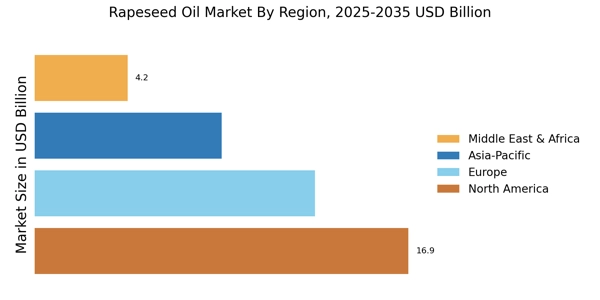Growing Demand for Biofuels
The increasing demand for biofuels is emerging as a crucial driver for the Rapeseed Oil Market. Rapeseed oil is a key feedstock for biodiesel production, which is gaining traction as a sustainable energy source. With governments and organizations pushing for renewable energy solutions, the market for biodiesel derived from rapeseed oil is projected to expand significantly. Current estimates indicate that the biodiesel sector could account for up to 30% of the total rapeseed oil consumption by 2026, highlighting the potential for growth in this segment of the market.
Health Benefits of Rapeseed Oil
The Rapeseed Oil Market is experiencing a surge in demand due to the increasing awareness of health benefits associated with rapeseed oil. Rich in omega-3 fatty acids and low in saturated fats, rapeseed oil is perceived as a healthier alternative to other cooking oils. This shift in consumer preferences is reflected in market data, indicating that the consumption of rapeseed oil has risen by approximately 15% over the past year. As consumers become more health-conscious, the demand for rapeseed oil is likely to continue its upward trajectory, further solidifying its position in the market.
Versatility in Culinary Applications
The versatility of rapeseed oil in various culinary applications is a significant driver for the Rapeseed Oil Market. It is utilized in frying, baking, and salad dressings, appealing to a wide range of consumers. This adaptability not only enhances its marketability but also contributes to its growing consumption. Recent data suggests that the culinary sector has seen a 20% increase in the use of rapeseed oil, as chefs and home cooks alike recognize its neutral flavor and high smoke point. This trend indicates a promising future for rapeseed oil as a staple ingredient in kitchens worldwide.
Expansion of Food Processing Industry
The expansion of the food processing industry is a notable driver for the Rapeseed Oil Market. As the global population continues to grow, the demand for processed food products is on the rise. Rapeseed oil is favored in food processing due to its stability and health benefits. Recent statistics show that the food processing sector has increased its use of rapeseed oil by 18% over the past year, indicating a robust market for this oil. This trend suggests that the rapeseed oil market will likely thrive as the food processing industry expands.
Rising Awareness of Sustainable Agriculture
The Rapeseed Oil Market is benefiting from the rising awareness of sustainable agricultural practices. Consumers are increasingly seeking products that are produced with minimal environmental impact. Rapeseed oil, often cultivated using sustainable farming methods, aligns with this consumer preference. Market data indicates that sales of sustainably sourced rapeseed oil have increased by 25% in the last year, reflecting a shift towards eco-friendly products. This trend suggests that as sustainability becomes a priority for consumers, the demand for rapeseed oil will likely continue to grow.


















Leave a Comment